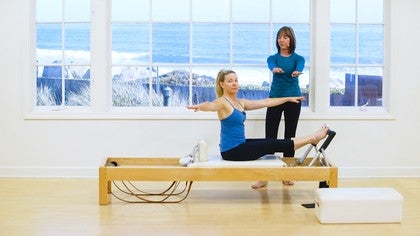Stomach Massage Progressions
Pat Guyton
Tutorial 3153
Watch this Tutorial


Vanessa C
Mind blown, Pat Guyton I love how you use the words "suggest" and "invite". It removes the pressure of perfection(which is not a pilates principal) and the wrong way, right way mentallity. Some of the basic work could also be great for those with osteoporosis!
8 years ago
Question: She's lifted and rounded with a "Happy Dog" pelvis at 10:29. . . right? (Just clarifying because when I hear rounded I'm not sure if that's for the entire spine including pelvis or just lumbar and UP)
8 years ago
Great Request! I am going to clarify a question that comes up within teaching that may be helpful with this answer. The sacrum is curved and it is bone. The coccyx follows the same curve and it is bone, but there is a joint between the two which allows for muscle movement in the pelvic floor. This sounds obvious and too simplistic, but my last group of trainees told me that they needed this reminder in imaging the dog tail. We also got on all fours and noticed that the coccyx would be pointing backward if the dog was happy. In humans on two legs, the coccyx not visible. I laugh and tell my students that this movement should be felt and not seen! The feeling of the happy dog is associated with the sacrum nutating. Therefore the coccyx relatively goes backward. This is very small but does activate the pelvic floor muscles.
8 years ago
When rounding forward, the pelvis stays in position on the sit bones which are the pelvic halves and contain the hip joints. As the lumbar, thoracic, etc move forward into the curve, the sacrum and coccyx is relatively rounded but the weight remains equal on the sit bones and the pelvic halves do not move into posterior or anterior tilt. When returning to sitting the cue of happy dog informs the pelvic floor muscles and the sacrum nutates to bring the vertical curve to neutral. Then the tail is relatively moves backward. Does this help? I am always open to a chat. The anatomy is complicated and this simple cue helps optimize the movement in the spine, but like all cues it works for some and not for others.
8 years ago
"As the lumbar, thoracic, etc move forward into the curve, the sacrum and coccyx is relatively rounded but the weight remains equal on the sit bones and the pelvic halves do not move into posterior or anterior tilt. When returning to sitting the cue of happy dog informs the pelvic floor muscles and the sacrum nutates to bring the vertical curve to neutral. Then the tail is relatively moves backward."
I generally follow some of this (weight remaining equal on the sit bones, no pelvic tilting) but I'd need more information (and focus!) to be clear.
Thanks for the detailed break down!
I generally follow some of this (weight remaining equal on the sit bones, no pelvic tilting) but I'd need more information (and focus!) to be clear.
Thanks for the detailed break down!
8 years ago
I know! It takes some time to follow the movement of the bones. I am always available.
8 years ago
Thank you so much Pat. I loved everything about this tutorial and will be using Happy Dog / Naughty Dog in my classes going forward. Especially loved your final comments...Perfection is not a pilates principle. Find enjoyment and pleasure within the process. Thanks again. xx
6 years ago
Thank you! I enjoyed sharing this tutorial. My mission is to give what I have learned through experience or direct teaching from my mentors for the purpose of helping others attain a bigger tool belt for their teaching pleasure and in service to others.
6 years ago
Excellent instruction! Thank you! Can't wait to teach naughty dog/happy dog as a precursor to successful stomach massage.
4 years ago
11-20 of 22
You need to be a subscriber to post a comment.
Please Log In or Create an Account to start your free trial.

















